kugelhopf cake, austrian/alsacian specialty
Kugelhopf: A yeast cake from Alsace, of Austrian origin, containing raisins or currants and cooked in a special high crownlike mould. The word is spelt in various ways (kougelhof, gougelhopf, or kouglof) and is derived from the German Kugel (a ball). It is said that Marie Antoinette’s fondness for this type of dough made such cakes very fashionable. However some authorities consider that it was Careme who popularized the cake in Paris, when he was pastry chef at the Avice. It is said that he was given the recipe by Eugene, head chef to Prince Shwarzenberg, the Austrian ambassador to Napoleon. Others claim that the first pastrycook to make true kugelhopfs in Paris was a man named Georges, who was established in the Rue de Coq in 1840. In Alsace, kugelhopf is eaten at Sunday breakfasts, and traditionally prepared the night before, as it is always better when slightly stale. It goes well with Alsace wines.
Source: Larousse Gastronomique
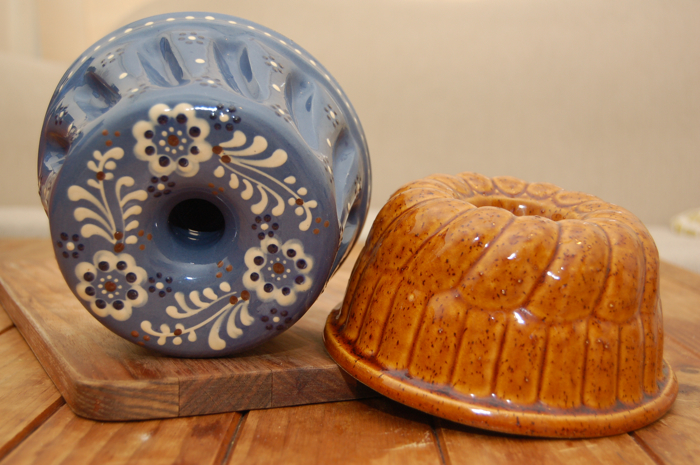 ceramic kugelhopf molds from Germany
ceramic kugelhopf molds from Germany
On my trip to Germany last year, I spent a great deal of my time searching for a ceramic kugelhopf mold. But all I could find was metal cake tins that looked the part. But I can get these here in Sydney, and apart from being functional, they had none of the romance. I finally found one in a lovely ceramics shop in Bamberg, and though it is probably not what a baker might use to make industrial strength kugelhopf, form met function and I took it home. I showed it to my lovely host Bertrun, who was surprised as she didn’t know I was after a kugelhopf mould, and insisted on giving me one her mother had given her. So, after many a thank you, I became the proud owner of two fantastic kugelhopf molds. Let us all marvel at their beauty.
a beautiful view of Bamberg, the source of the mold
Before I even tried this cake, I was always attracted to its unusual, regal figure. I imagined, as a yeast bread, it would resemble a brioche in flavour, or a panettone, and now I can confirm that. I feel it has a much more interesting shape than a brioche, and a better texture than a panettone, and it is a sure crowd pleaser. It does take a while to make but it’s worth it, and the job is made much easier if you have a mixer with a dough hook attachment. The recipe I attempted is from Culinaria France, and I found that they greatly underestimated the ratio of wet and dry ingredients. My tip is to keep some flour aside at the end to add to the mixer if the dough is too runny. It should feel wet, but still maintain an elasticity and body. My method uses the electric mixer with a dough hook. Replace with kneading and use double the time if you don’t have one.
Kugelhopf Recipe (makes 2 large cakes)
Ingredients
- 4 tbsp/30 ml kirsch (or your favourite spirit, I used rum and brandy)
- 1 cup/150 g sultanas or currants (more if you love a lot of sultanas)
- 1 kg plain flour
- 30 g compressed yeast
- 2 cups/500 ml milk
- 1 tbsp/10 g salt
- 2/3 cup/150 g sugar
- 5 eggs
- 3/4 cup/180 g soft butter
- 2 tbsp almond flakes
try to achieve the texture in this photo when making your kugelhopf
Method
- Pour the kirsch over the currants, stir, leave covered for a few hours to soak
- Warm half the milk till lukewarm
- Prepare the started dough by pouring 300 g flour into the mixer bowl, crumble in the yeast and the cup of lukwarm milk you prepared in step 2. Knead lightly in mixer and leave to prove for 2 hours
- Place the dough back in the mixer bowl and top with the remaining milk, 500 g flour, salt, sugar and the eggs and mix for at least 10 minutes, which is very important for the texture of the cake. The loose semi-solid dough should come away from the bowl easily.
- Mix in the butter and knead the mixture until it becomes a smooth supple dough
- Add the sultanas/currants and work them in until they are evenly distributed in the dough
- Grease two cake molds (preferably kugelhopf molds) with butter and sprinkle the almond flakes evenly in them. Fill the mold up to halfway with the dough and leave to prove in a draught-free place
- Preheat the oven to 200 C and bake the kougelhopf for around 20 to 30 minutes, depending on the size of the mold.
- When the surface of golden brown, remove the came from the oven and leave it to cool on a cakestand. The top will swell to become like a ball, which explains the name 🙂
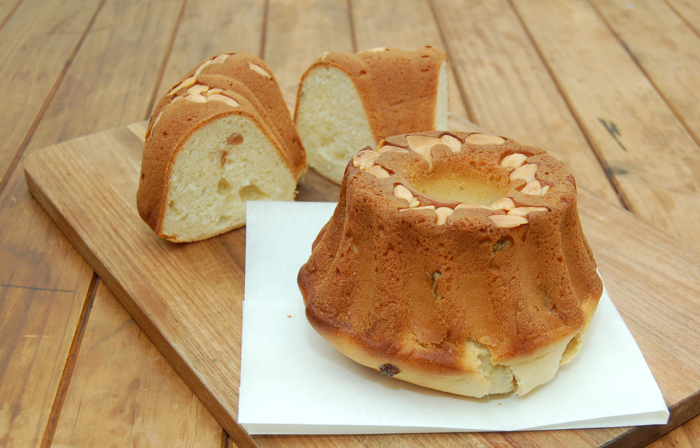
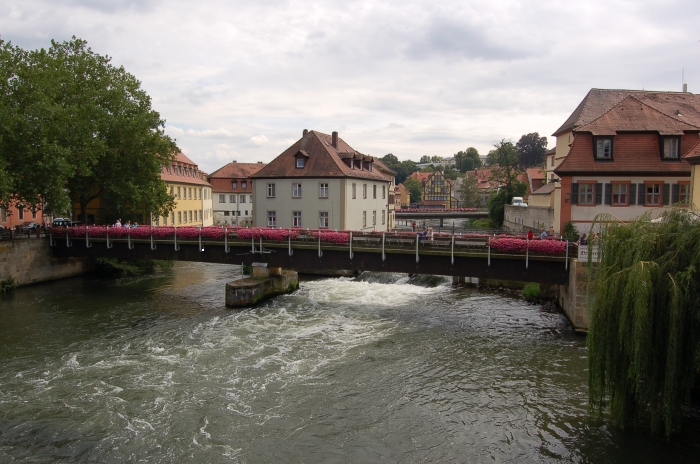

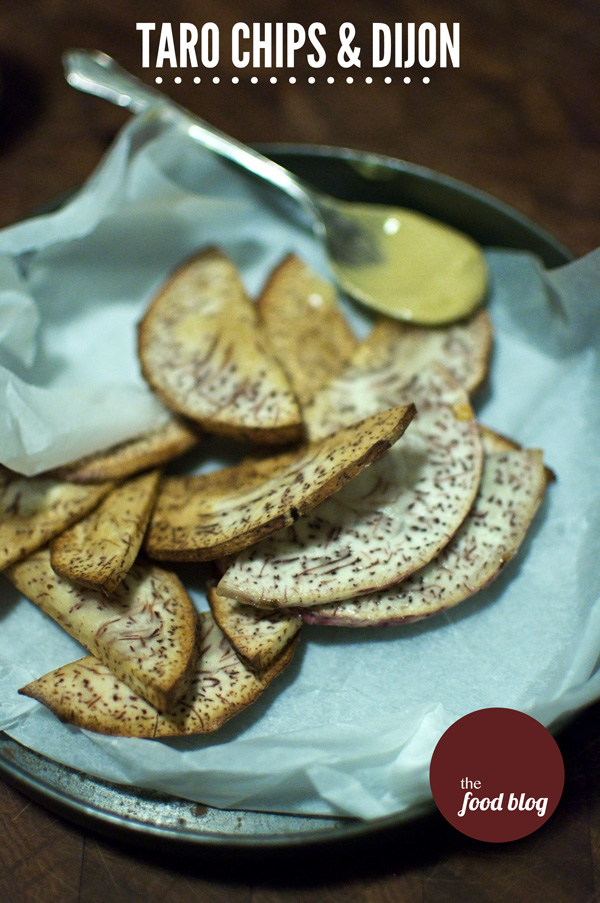
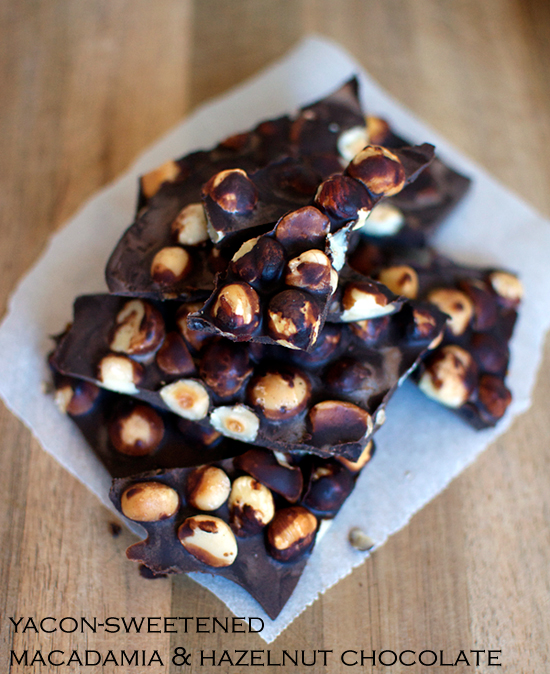
12 comments
Such pretty molds, and oh, how funny how one minute you had none, the next you had two!
I love the photo of the K cake and the molds! I am a (small) collector of cookie molds. I was wondering what type of flour did you use specifically?
BRead, all-purpose, unbleached, etc?
That photo of that charming town in Germany reminded me of a town in France called Moret-sur-Loing, with a river running through it like that one and a castle with a dungeon ; we used to live nearby.
/cecinestpasungateau.1s.fr/
I read this site a lot and get inspired and i thought of you when he talked about the K at ladurée in paris as being the best, and he says it is because of the ceramic molds they use!
Helen – thanks for reading 🙂 they are beautiful aren't they!
Jouamana – I used all purpose flour and it turned out great. Bamberg is my city of dreams. Have a look at the foraging expedition I had there. It was stunning: http://thefoodblog.com.au/2009/08/foraging-babmberg.html
Kuglóf ("bábovka" in my language) is a common cake also in my country – Slovakia. There are many diferent recipes. I see, you are using the one with yeast. Nice one!
I use this old recipe from Bratislava (Presburg): 5 eggs, 6 large spoons of sugar, 1dcl sour cream (or creme fraiche), 125g flour, cherries, cinamon, star anise, butter and flour for greasing the mold.
Beat the egg yolks together with sugar. When smooth, add creme fraiche. Next add flour. Beat egg whiteswith a tiny little bit of salt into hard peaks. Half the desseded cherries, cover them in cinamon and star-anise powder. Put half of the cherries into the mixture. Gently mix in the egg whites. Grease the kuglof mold with butter and dust with flour. Pour in the dough. After that,add the rest of the cherries on the top of the dough. Bake for about 45mins at 180C.
Best with coffee, it used to be a typical breakfast cake in Slovak cafes… It was the first cake my mum taught me.
oh, I forgot to paste images to my recipe http://www.delikatesy.sk/255/povodne-lokalne/kam-zmizol-kuglof/ (sorry, site in Slovak language)
Hi Viktor. Thanks for the recipe and great photos. I wish I could understand slovak 🙂
Went on a Gourmet Safari on Saturday and tasted my first Kugelhopf from Wellington Cakes in Bondi. It was a chocolate version where the chocolate was swirled with the pastry/cake. Loved it as it was not too sweet and the chocolate not too strong.
These moulds look very cool. I like how fluffy and light this looks. I am not sure if its a cake or bread. Well done.
.-= Mark @ Cafe Campana´s last blog ..The Ten Commandments of the Grill – Cafe de Paris Butter =-.
i have a traditional alsace kugelhopf mold. i lost the directions for how to care for it. before first use, i’m supposed to bake the mould twice with a coat of oil. i think the temperature should be 180f, but i am uncertain.
your kugelhopf mould looks interesting, because in malaysia, here got no such mould. by the way, i am very curious about the texture of this food.thanks for sharing and i’m going to make it today..wish me luck!
wow, this is interesting, i mean the texture. it is not as soft as cake and not as chewy as bread. it is so special and my mother in law like it too because it is more tasty then bread.. mmm.. my son love it when i apply butter on it..oh ya, i added some orange rind to make it more fragrant. thanks for sharing~